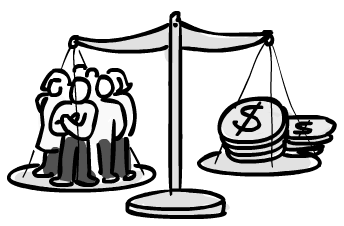 I have to admit, doing a guest post for PMStudent was harder than I thought it would be. I've been wanting to do it for a while but haven't because I couldn't think of the perfect topic and then wound up posting all of those topics on my own site. What would be good enough for this guest post? Clearly, the answer was whatever is good enough to post on my own site! I've done a guest post before, writing about the challenges to task prioritization at the Personal Kanban website. Still, pondering a topic and writing about it are two very different challenges. I finally followed through and completed my guest post. After I let go of my anxiety, it was really quite easy.
I've been following Josh Nankivel, and his PMStudent blog, since I first logged onto Twitter and started PM blogging. Josh is an excellent resource for anyone in the PM industry. Particularly, he is passionate about helping new and aspiring project managers succeed. It shows! Since I aspire to do the same thing, you can understand my trepidation in choosing a topic for my guest post on his blog.
I have to admit, doing a guest post for PMStudent was harder than I thought it would be. I've been wanting to do it for a while but haven't because I couldn't think of the perfect topic and then wound up posting all of those topics on my own site. What would be good enough for this guest post? Clearly, the answer was whatever is good enough to post on my own site! I've done a guest post before, writing about the challenges to task prioritization at the Personal Kanban website. Still, pondering a topic and writing about it are two very different challenges. I finally followed through and completed my guest post. After I let go of my anxiety, it was really quite easy.
I've been following Josh Nankivel, and his PMStudent blog, since I first logged onto Twitter and started PM blogging. Josh is an excellent resource for anyone in the PM industry. Particularly, he is passionate about helping new and aspiring project managers succeed. It shows! Since I aspire to do the same thing, you can understand my trepidation in choosing a topic for my guest post on his blog.
My topic of choice was on "Contract type: Here’s the best one…"
Unfortunately, there is no ONE best type of contract because the risk the vendor and customer share is determined by the contract type. The best thing to do is understand who bares the risks or benefits of each. Being I don't know if you (the reader) are a vendor, a customer, or a project manager, I offered an objective description of each contract type to help shed some light on the subject.
Please check out Josh's blog and let me know what you think of the post. Scathing reviews are welcome. OK, that's a lie. No scathing reviews, please. I hope this is the first of many guest posts I will be doing. If you want me to write something for your site, please send me an email or direct message me on Twitter.
Now that I published some information on the PMStudent site, I think I'm going to add a little more content and provide it for download, as an informative product.
 I was in a contract negotiations meeting for several hours yesterday. The most notable quote came after the customer was asking for the basis of estimates for the scope of work being proposed.
I think both the vendor and customer could have done a lot better if they had just valued customer collaboration over contract negotiation.
I was in a contract negotiations meeting for several hours yesterday. The most notable quote came after the customer was asking for the basis of estimates for the scope of work being proposed.
I think both the vendor and customer could have done a lot better if they had just valued customer collaboration over contract negotiation.



